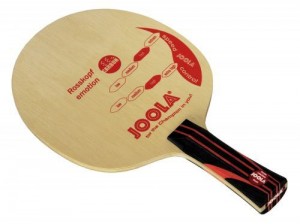Table tennis Racket Regulations
Like every sport, table tennis has specific rules to follow. We constantly hear about the importance of having a regulation racket when playing, so we have complied a list of all the requirements below:
1. The racket may be of any size, shape or weight but the blade shall be flat and rigid.
2. At least 85% of the blade by thickness shall be of natural wood; an adhesive layer within the blade may be reinforced with fibrous material such as carbon fibre, glass fibre or compressed paper, but shall not be thicker than 7.5% of the total thickness or 0.35mm, whichever is smaller.
3. A side of the blade used for striking the ball shall be covered with either ordinary pimpled rubber, with pimples outwards having a total thickness including adhesive of not more than 2mm, or sandwich rubber, with pimples inwards or outwards, having a total thickness including adhesive of not more than 4mm.
4. Ordinary pimpled rubber is a single layer of non-cellular rubber, natural or synthetic, with pimples evenly distributed over its surface at a density of not less than 10 per sq. cm and not more than 30 per sq. cm.
5. Sandwich rubber is a single layer of cellular rubber covered with a single outer layer of ordinary pimpled rubber, the thickness of the pimpled rubber not being more than 2mm.
6. The covering material shall extend up to but not beyond the limits of the blade, except that the part nearest the handle and gripped by the fingers may be left uncovered or covered with any material.
7. The blade, any layer within the blade and any layer of covering material or adhesive on a side used for striking the ball shall be continuous and of even thickness.
8. The surface of the covering material on a side of the blade, or of a side of the blade if it is left uncovered, shall be matt, bright red on one side and black on the other.
9. The covering material should be used as it has been authorised by the ITTF without any physical, chemical or other treatment, changing or modifying playing properties, friction, outlook, colour, structure, surface, etc.
10. Slight deviations from continuity of surface or uniformity of colour due to accidental damage or wear may be allowed provided that they do not significantly change the characteristics of the surface.
11. At the start of a match and whenever he changes his racket during a match, a player shall show his opponent and the umpire the racket he is about to use and shall allow them to examine it.

